Review how to integrate digital marketing into your marketing team's structure through Digital Transformation
The latest Smart Insights research study shows how common Digital Transformation projects or programme are today with 30% already having a programme up & running and 31% planning to within the next year.
Yet, digital transformation doesn’t occur overnight. There are a series of steps to go through to get there and the critical factor is the staff. Imagine a world where your Digital Working Party, Digital Group, or Digital Collective is in place, they’ve had several meetings and agreed on an action plan! What’s next? Let's take look at options and examples of how you structure your digital team. Also, crucially, what does this mean in terms of your marketing funnel?
We've got marketing tools and templates to support you in building a strong digital strategy, and structuring your marketing team to get the most out of digital. Smart Insights members are making use of our integrated marketing framework, the RACE Framework, to optimize their marketing funnels.
Free digital marketing plan template
Our popular marketing planning template is structured across the Smart Insights RACE Framework. Join Smart Insights as a Free Member to download our digital marketing plan template today
Access the Free digital marketing plan template
Creating and managing digital teams
Where does the responsibility for managing digital teams lie? It’s an interesting question and one I’ve had to answer several times. The answer?
It depends.
- It depends on the size of the business.
- It depends on the business locations.
- It depends on the appetite for digital within the business.
- It depends on the nature of the business – b2c often has to move faster than b2b.
- It depends on the skillsets within the business.
- It depends on who the senior team member is and to whom they’ve given the authority to get the job done.
- It depends on negotiation between departments.
Nigel Fenwick author of the Forrester State of Digital Business report, which polled 1,591 senior business leaders in the UK and US, revealed major disconnects between the marketing and technology sides of businesses, with responses signaling a “digital strategy execution crisis”. He recommends CMOs and CIOs working together to ensure businesses don’t adopt a bolt-on strategy. I'd agree that this is essential if not, it can go wrong:
It started so well. We all agreed our tasks, a timescale and at the very next meeting, the head of sales said they couldn’t do their tasks because they were busy with sales! I could have screamed!
You may have experienced this and it’s all about getting the team in place before embarking on digital transformation. Jason Mogus, Michael Silberman, and Christopher Roy defined 4 types of digital business structures that are useful for considering the type of Centre of Excellence structure that could work best for you. You will see they are presented as an evolution.

1. The Informal Digital Transformation Model
The informal model is where most businesses start or started. One lone voice spreading the digital word in the building. You would think this is rare today, 25 years after the launch of the web, but we meet members who at least feel it is this way.
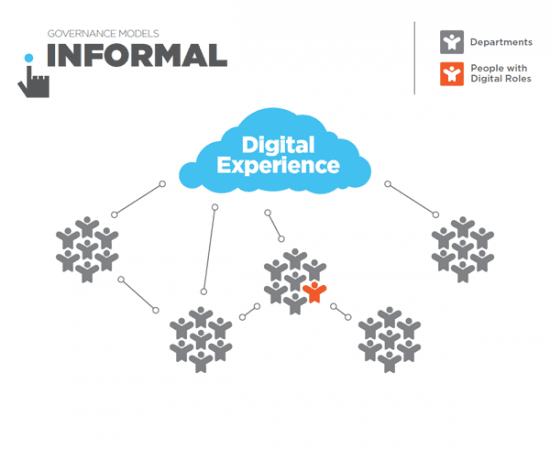
2. The Centralised Model
The centralized model tended to follow next as there was a knee-jerk reaction to ‘do digital’ and often separate departments were formed. The challenge with this model and I’ve seen this first hand, is that other departments adopt a ‘nothing to do with us’ approach. It also means digital is siloed in one area.
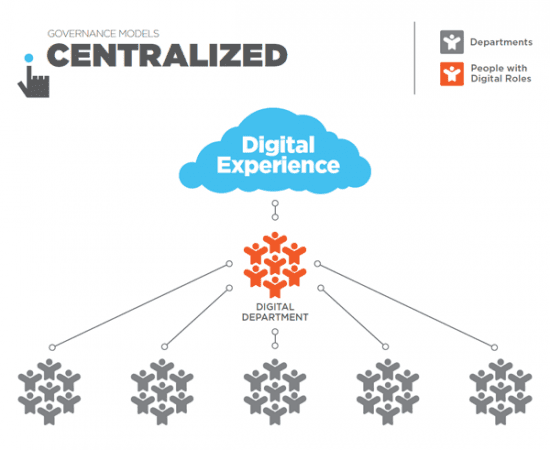
3. The Independent Model
Independent was the third model and this is common in mid-sized organizations where they do not have the luxury of larger teams. Again, this works relatively well, the challenge here is the lack of overall control and coordination.
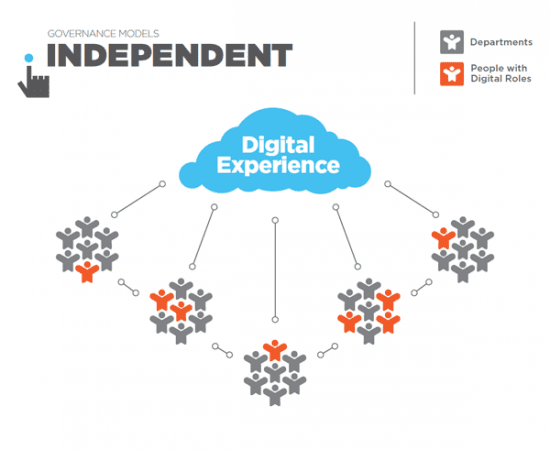
4. The Hybrid Model
Hybrid is the nirvana where there’s one team in overall control: delivering training; providing support; and strategic guidance. In the field, there are individual digital experts.
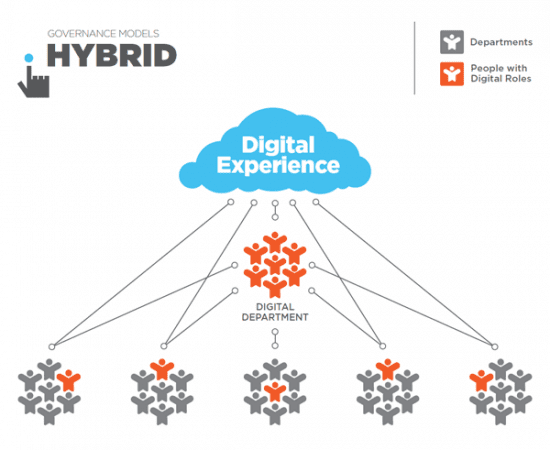
The evolution of digital transformation
In 2013, in their manifesto “The evolution of social business”, Charlene Li and Brian Solis identified key methods of organization of social business which ranged from decentralized to holistic. The multiple hub and spoke is effectively where Mogus, Silberman, and Roy stopped. In Li and Solis’s version, the nirvana is a holistic model. This looks very much like the future, rather than the present.

Digital marketing excellence
In the Smart Insights Guide to Managing Digital Transformation, Dave Chaffey, Sophia Ahrel and James Carson look at different ways of managing digital transformation. They also identify that the holistic version seems difficult to achieve. They look at the concept of centralization, commonly termed ‘Centres of Excellence’.
Whilst the concept works well with international organizations, it also translates easily for large and mid-sized enterprises, where staff may be in the same country (or same office).
This concept recommends a center of excellence, where key skills that may not be needed in each department daily, are pooled. In the same way, companies have one HR team, but there may be one specialist in recruitment techniques.
The other advantage of this approach is that a central team may provide training, manage websites, brand development of social spaces, and support other computer-mediated environments whereas country managers create content, maintain the social media networks and organize local implementation.
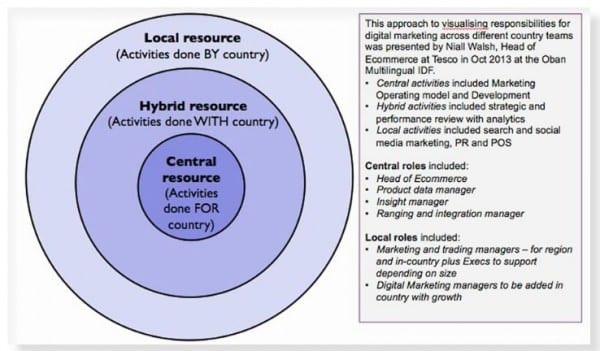
Digital marketing strategy and planning
If you're looking to transform your company through digital strategy and planning, you need a clear vision, and objectives to track your progress. This is where Smart Insights can help, since, as well as expert guides and resources, Business Pro Membersip includes your very own success manager in the team, who will guide you to meet your goals.
To find out more about digital opportunities for your business, why not book a free 1-2-1 consultation call to kick off these discussions and discover how your business can benefit from digital transformation? Need a winning marketing strategy?
Book your free 1-2-1 consultation to develop your new strategy with the RACE Framework
Book consultation
T-shaped marketing skills
The Guide also looks at the T-shaped marketer, understanding a wide range of disciplines but with deep skills in one specific area. In my view, the ideal business scenario comprises a center of excellence and individuals throughout the business with digital expertise, which may be T-shaped, depending on the business needs.
For examples of job descriptions and digital roles, see the Guide to Managing Digital Transformation and our digital marketing Job Description Templates and Role Definitions.
Selecting the project
It can be overwhelming knowing where and how to start and to avoid this situation, it’s essential to focus on one specific project to start. In 2014, George Westerman, Didier Bonnet and Andrew McAfee, a team at MIT interviewed 157 executives in 50 companies to identify digital opportunities. They discovered three key areas that benefit from digital intervention:
- Customer experience;
- Operational processes and
- Business models.
For your business, this could include:
Operation processes and Customer experience
Respond faster to customer queries by moving customer services to a social platform.
The interim steps include mapping out the social media tools to be used by the group: start by observing competitors; listening to conversations; formulating best practices – with external advice and preparing a timed plan to take this forward. The advantages are that in the past there may have been many customers making telephone calls about one subject and moving to digital means sharing that response online so that it can be spread amongst many customers.
A great example of this is UCAS, this is the UK’s university admission service. In the past, they had hundreds of people taking phone calls, often the same call, from many students. Today, they’ve got a great Facebook page and promote online events, such as this Q&A session.

Digital transformation business model
Save product development time and costs by gathering new product ideas via social media.
The interim steps are similar to above: observing competitors; listening to conversations; formulating best practices and preparing a timed plan to take this forward.
Many companies have used social media for product development, especially food and drink brands including Walker’s Crisps, Cadbury’s Chocolate, and Vitamin Water.
Where is product or service development needed in your business? Can a new idea make your business disruptive and provide a greater, stronger, online value proposition?

Customer experience
Sharing documents with clients in the cloud so they can access anywhere, anytime.
I’ve been working on a new website and the web team, iWeb, used Trello, a cloud-based project management system, for the entire process. Once signed off, every step was added to the ‘to do’ section. As milestones were approaching, individual tasks were placed on cards, and the project manager appointed team members to do the work and set deadlines.
Everyone in the team – and there were people in several different locations involved, received regular updates and reminders when tasks were due. Every item needed for the project; artwork, images, content, was all uploaded into this central system – this stopped the issue, which I’ve seen many times, where people haven’t received the items or can’t find them, as they were all in the central area.
Other cloud project management systems include Basecamp which is used by Smart Insights. The key factor with these cloud-based systems is that clients have total access to every step of the process and can see all the questions being asked. There is more transparency and greater understanding when there are issues.
We've got marketing tools and templates to support you in building a strong digital strategy, and structuring your marketing team to get the most out of digital. Get started today. 
Getting started with your digital transformation strategy now
Instead of creating major pieces of work which many will postpone on the basis that there’s so much to do and difficult to see where to start and then waiting until you get to the meeting to find out where you are, take smaller steps:
- Break up big tasks into many smaller actions to be shared
- Get all the actions on to a cloud-based system with one overall project manager who assigns tasks and liaises with all departments
- Appoint ‘product owners’ for specific tasks
- Identify the quick wins that can easily be achieved, so the team sees results sooner
- Have faster, shorter meetings – the 20-minute catch-up – this can be face to face or Skype
- Encourage product owners and their supporters to meet to get the work done
- At the meetings, say ‘thank you’ to people who have carried out their tasks – acknowledgment matters!
And one key issue is that the team may not know each other well. Where possible, organize an external event, even if it’s drinks after work or a working lunch or coffee and cakes. Anything to get people talking and finding common ground. If it’s a remote team, send doughnuts!
If it’s a larger project, especially with an international company, a start-off meeting in a central location is a great way to start, foster community spirit, put names to faces, and create motivation.
The RACE Framework for Digital Transformation
Crucially, what framework is your team using to structure its digital marketing? Our Business Members are using the RACE Framework to plan, manage, and optimize their marketing strategies integrated across the customer lifecycle of reach, act, convert, and engage.
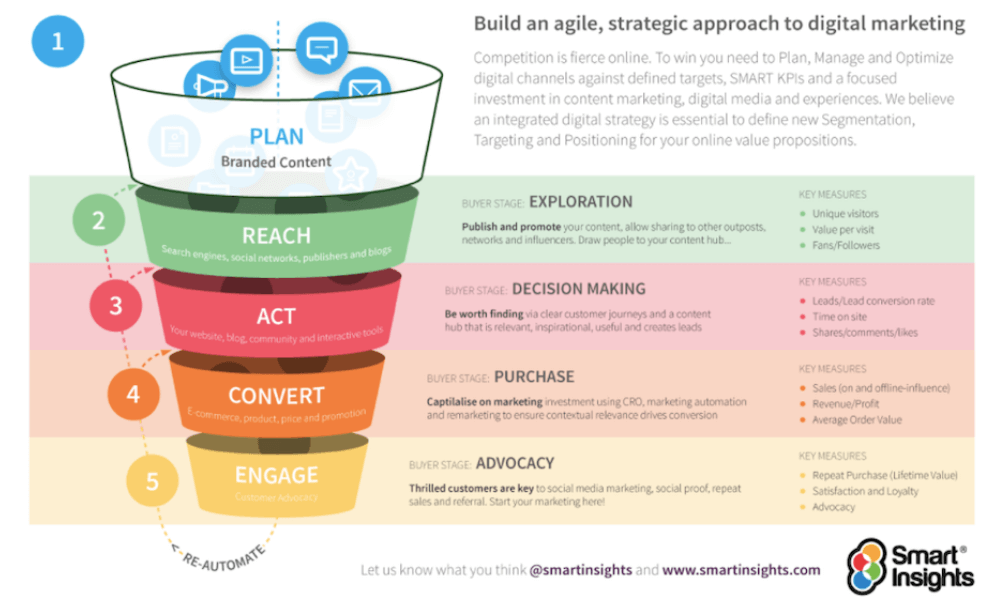
When and what to outsource
Finally, there’s the question of what to do in-house and what to outsource. Many companies use agencies for design, creative and ads which is great, but don’t forget to include them in the relevant meetings so they know what’s expected of them and how it all connects.
I’m seeing more and more companies managing their video production. Two recent examples, both multi-nationals, where the target audience was b2b and they’ve brought video skills in-house. This was part of a wider ‘reach’ strategy and considering that YouTube is still the second largest search engine, for both it was a wise decision.
Content creation is an interesting area. If we consider content as pure words, not images, video, or sound, in the USA it’s popular to outsource, in the UK it’s in-house. This decision depends on your business needs and target audience. I’ve worked with both scenarios as well as a blended mix where some content is created in-house and other content is outsourced.
Outsourcing your digital transformation activities
So what are the key areas to outsource? Here are my picks of the top four areas to outsource to get your digital transformation started:
- Non-written content – images, design, style guides to ensure the team follows a consistent theme. Ensure the style guide addresses offline as well as online. And if you’re not a multi-national, you may wish to outsource video production too.
- Training – buy-in training in key areas such as digital strategy, managing Facebook pages, or whatever social media you’re using. Expert trainers often have a wider breadth of skills and examples they can share with you. In-house training courses can also be great ice-breakers for teams working together for the first time.
- Project launch – consider an expert to facilitate the project launch, acting as part-mediator to transfer knowledge, agree ground rules, and develop the road map.
- Set-up – if you’re setting up analytics or other dashboards, get an expert and save so much time.
To find out more about digital opportunities for your business, why not book a free 1-2-1 consultation call to kick off these discussions and discover how your business can benefit from digital transformation? Need a winning marketing strategy?
Book your free 1-2-1 consultation to develop your new strategy with the RACE Framework
Book consultation

















